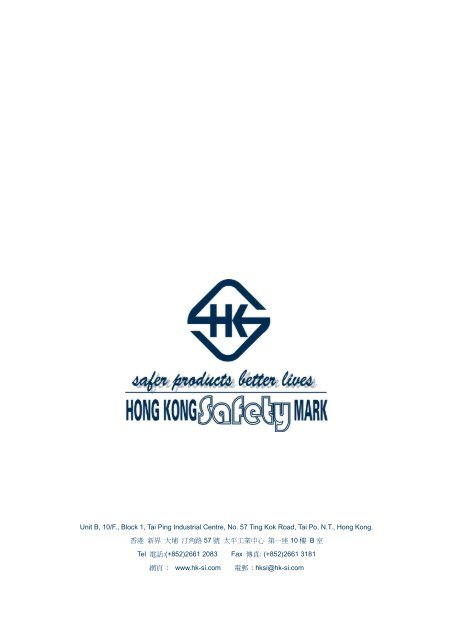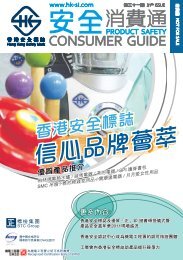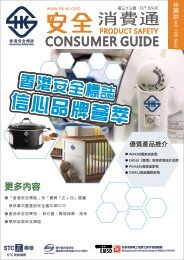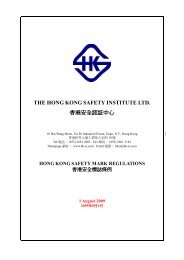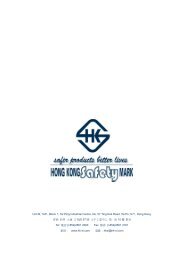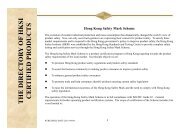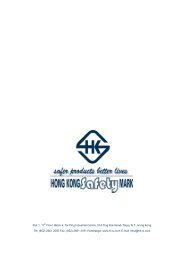Electrical Products
Electrical Products
Electrical Products
Create successful ePaper yourself
Turn your PDF publications into a flip-book with our unique Google optimized e-Paper software.
Unit B, 10/F., Block 1, Tai Ping Industrial Centre, No. 57 Ting Kok Road, Tai Po, N.T., Hong Kong.<br />
香 港 新 界 大 埔 汀 角 路 57 號 太 平 工 業 中 心 第 一 座 10 樓 B 室<br />
Tel 電 話 :(+852)2661 2083 Fax 傳 真 : (+852)2661 3181<br />
網 頁 : www.hk-si.com<br />
電 郵 : hksi@hk-si.com
<strong>Electrical</strong> <strong>Products</strong> –<br />
Household and Similar Use Appliances<br />
Scheme No. : SI/SCH/001<br />
Issue Date : 2007-07-18<br />
Revision : 1
Table of Content<br />
1. INTRODUCTION .......................................................................................................................... 1<br />
2. SCOPE ............................................................................................................................................. 1<br />
3. CERTIFICATION MODE ............................................................................................................. 2<br />
4. CERTIFICATION – PRE-LICENSE STAGE ............................................................................. 3<br />
4.1. APPLICATION TO HONG KONG SAFETY INSTITUTE ..................................................................... 3<br />
4.2. PRODUCT TYPE TEST ................................................................................................................. 3<br />
4.2.1. Classification of Certification Product ............................................................................. 3<br />
4.2.2. Sample preparation ........................................................................................................... 4<br />
4.2.3. Applicable Testing Standards ............................................................................................ 4<br />
4.3. INITIAL FACTORY EVALUATION .................................................................................................. 4<br />
4.3.1. Factory Inspection – Quality Assurance Ability Inspection .............................................. 4<br />
4.3.2. Product Consistency Check .............................................................................................. 5<br />
4.4. OVERALL REVIEW ..................................................................................................................... 5<br />
4.5. ISSUE OF HONG KONG SAFETY MARK LICENSE......................................................................... 6<br />
4.6. CONTINUAL SURVEILLANCE ...................................................................................................... 6<br />
4.6.1. Routine Inspection Visit .................................................................................................... 6<br />
4.6.2. Type Test Assessment ........................................................................................................ 6<br />
5. PRODUCT MODIFICATION ....................................................................................................... 7<br />
6. PRODUCT SCOPE EXTENSION ................................................................................................ 7<br />
7. CERTIFICATION SUSPENSION/ CANCELLATION .............................................................. 8<br />
8. REGULATIONS FOR CERTIFICATION MARK ..................................................................... 9<br />
APPENDIX 1 – PRE-LICENSE OVERVIEW WORK FLOW ....................................................... 12<br />
APPENDIX 2 – TESTING STANDARDS AND REQUIRED SAMPLE ......................................... 13<br />
APPENDIX 3 – CRITICAL COMPONENT REQUIREMENTS .................................................... 16<br />
APPENDIX 4 – FACTORY INSPECTION REQUIREMENTS ...................................................... 17
1. Introduction<br />
The Hong Kong Safety Mark Scheme is an independent certification program for product<br />
safety in Hong Kong.<br />
This document aims to introduce certification requirements of the Hong Kong Safety Mark<br />
(HKSM) Scheme on electrical appliances.<br />
This Scheme has referenced ISO Guide 67 and <strong>Electrical</strong> <strong>Products</strong> (Safety) Regulation (EPSR)<br />
made under the <strong>Electrical</strong> Ordinance (Cap.406) of HKSAR.<br />
Remark :<br />
HKSM Scheme will not address the requirements of Electro-magnetic Compatibility (EMC)<br />
2. Scope<br />
HKSM scheme accepts application from and is accessible to all applicants including<br />
manufacturers, importers, distributors and retailers, so long as the application falls within the<br />
scope of the scheme, which includes, but is not limited to, the following:<br />
• Air Cleaning appliances • Frying Pans<br />
• Air Curtains • Grills, Roasters and Toasters<br />
• Air Purifiers • Hair Clippers<br />
• Air Conditioners / Dehumidifiers • Humidifiers (No refrigerant)<br />
• Appliances for heating liquids – Rice<br />
Cooker, Slow Cooker, Thermal Po<br />
• Ice-makers<br />
• Appliances for skin or Hair Care • Induction Cookers<br />
• Battery Chargers • Insect Killers<br />
• Bio-energy Lantern • Instantaneous Water Heaters<br />
• Centrifugal Juicers • Massage Appliances<br />
• Cleaning Appliances • Microwave Ovens<br />
• Clocks • Motor Compressors<br />
• Clothes Dryers • Oil filled Radiators<br />
• Computerized Multifunctional Toilet<br />
Bowls<br />
• Oral Hygiene Appliances – Toothbrush<br />
with Charger<br />
• Cooking Ranges • Outdoor Barbecues<br />
Page 1
• Deep Fat Fryers • Ovens<br />
• Dishwashers • Potable Heating Tools<br />
• Electric Dry Iron, Electric Steam Iron • Portable Immersion Heater<br />
• Electric Fans, Regulators and<br />
Ventilation Fans<br />
• Electric Grinders, Polishers and<br />
Disk-type sanders<br />
• Range Hoods<br />
• Refrigerators<br />
• Electric Hair Dryers • Sewing Machines<br />
• Electric Heated Blankets / Pad • Spin Extractors<br />
• Electric Ironers (with padded surface<br />
for pressing)<br />
• Soybean Milk Machine<br />
• Electric Kitchen Machines, Juicers • Thermal Storage Room Heaters<br />
• Electric Pump for liquids • Towel rails<br />
• Electric Sauna Heating Appliances • Treatment Caps<br />
• Electric Shavers • Tumbler Dryers<br />
• Electric Screen, Drapery Actuator • Ultra-violet and Infra-Red Radiation Skin<br />
Treatment Appliances<br />
• Electric Tea Pots • Vacuum Cleaners / Water Suction<br />
Cleaning Appliances<br />
• Electric Vibrators • Warning Plates<br />
• Fabric Steamers • Washing Machines<br />
• Fan Heaters • Water Dispensers<br />
• Floor Treatment • Water Heaters<br />
• Food Freezers • Wet Scrubbing Machines<br />
• Food Waste Disposers • Whirlpool Baths<br />
• Foot Warmers and Heating Mats<br />
3. Certification Mode<br />
The scheme adopts a “product-oriented” certification program. Applied products will be sent to<br />
be product type test to relevant testing standards. After complying with test requirements,<br />
HKSI will perform production site assessment. The aim of factory assessment is to ensure<br />
factory has a quality system able to manufacture the certified product steadily and production<br />
system complies with requirements.<br />
Page 2
Hong Kong Safety Mark will be granted to approve product and HKSM license issued to<br />
relevant Subscriber after satisfactory results from type test and factory assessment are<br />
obtained.<br />
Approved products and factories shall also be monitored by continual surveillance program,<br />
which it generally includes routine inspection visit at factory and type test program. The mode<br />
of certification is shown below:<br />
Certification Mode<br />
Product Type Test + Initial Factory Evaluation + Continual Surveillance<br />
4. Certification – Pre-license Stage<br />
4.1. Application to Hong Kong Safety Institute<br />
The Subscriber submits completed HKSM application form (F/001) together with following<br />
information to Hong Kong Safety Institute:<br />
• A copy of Business Registration Certificate ;<br />
• Photos/catalogues/pamphlets of the product(s) ;<br />
• Product specification;<br />
• Bill of Materials;<br />
• Circuit Diagram;<br />
• Assembly or Engineering drawing (if necessary);<br />
• User/Instruction manual.<br />
4.2. Product Type Test<br />
4.2.1. Classification of Certification Product<br />
(a) Individual model: Applicants shall arrange to send applied samples to HKSI. Type test<br />
will be conducted for submitted individual samples.<br />
(b) Models in series: If Subscriber has more than one model for application, and such<br />
Page 3
models have similar structures, functions or components, the representative samples from<br />
all applying models shall be selected for type test. The other models will be selected for<br />
conducting the additional test or verification in respect of the differences.<br />
4.2.2. Sample preparation<br />
Subscribers should submit samples to HKSI. The quantity of samples shall be according to<br />
requirement of Appendix 2. All submitted samples must be completed and good functional, and<br />
all critical components of applied product shall comply with the relevant requirement<br />
mentioned in Appendix 3.<br />
4.2.3. Applicable Testing Standards<br />
The testing standards for certification are specified in Appendix 2.<br />
4.3. Initial Factory Evaluation<br />
4.3.1. Factory Inspection – Quality Assurance Ability Inspection<br />
Factory inspection is to ensure Subscriber of certified product has an ability to produce such<br />
product and to ensure production conditions are complying with the relevant international<br />
requirements, including it has enough facilities, equipment and technique. The regulations of<br />
HKSM scheme shall also be introduced to Manufacturer, which basically include:<br />
• Factory situation complies with information stated in Factory Questionnaire, which is<br />
reported to HKSI upon application being made;<br />
• Hong Kong Safety Mark is granted only to products certified by HKSI;<br />
• The terms of Hong Kong Safety regulations are met when the Hong Kong Safety Mark is<br />
applied for;<br />
• Current Hong Kong Safety Marked production complies with appropriate requirements;<br />
• The required Factory Tests are conducted according to relevant certification report. Test<br />
Records are also maintained;<br />
• The factory test equipment is properly maintained and calibrated;<br />
• The records of customer complaints handling, follow-up action and usage of Safety Mark<br />
are maintained.<br />
The requirements of factory inspection shall be referred to in the Appendix 4<br />
Page 4
4.3.2. Product Consistency Check<br />
If any certified product is available in production line or warehouse, inspector shall select<br />
sample for the related critical component checking against the description of Certification<br />
report. Any difference between inspected sample(s) and description of HKSI certification<br />
report should be recorded in Factory Inspection Report.<br />
Also, the certified product should be checked for the workmanship on safety basis, including<br />
the soldering, welding, torque test for earthing screw, wiring connection, etc.<br />
Inspector shall require Subscriber’s manufacturing facilities to conduct factory tests for the<br />
selected sample. The specification of tests to certified product should refer to Certification<br />
Report’s requirements.<br />
The following marking must be indicated on the HKSM certified product, except the description<br />
on the relevant Certification Report:<br />
(i)<br />
Subscriber identification (Subscriber’s name, trademark and / or HKSI license number,<br />
adjacent to Hong Kong Safety Mark) and Hong Kong Safety Mark logo.<br />
(ii)<br />
Model designation or equivalent.<br />
(iii)<br />
Complete electrical rating of the product (including supply voltage, frequency, and power<br />
consumption.)<br />
(iv) Serial number or date code traceable to month and year of manufacture.<br />
(v)<br />
Instruction manual – all markings or label containing warning or caution words or phrases<br />
given in respect of the safe keeping, use consumption or disposal of the good will have to<br />
appear in both English and Chinese.<br />
(vi) Identification mark – Neutral symbol “N” and Earth symbol must be marked on the<br />
suitable place on the certified product, such as terminal block and connector, etc. (except<br />
type Z attachment)<br />
4.4. Overall Review<br />
Overall assessment review will be performed by HKSI after completion of product type test and<br />
Page 5
factory inspection.<br />
consideration:<br />
During the review, the following reports/records will be taken into<br />
• Information stated in the Application Form<br />
• Type test result<br />
• Result of factory inspection<br />
• Other submitted information/reports/ records for<br />
corrective actions found in certification process.<br />
4.5. Issue of Hong Kong Safety Mark License<br />
Hong Kong Safety Mark License could be granted to Subscribers when satisfactory result of<br />
overall review assessment is obtained. Subscribers are permitted to label HKSM onto certified<br />
products.<br />
The license includes the following information:<br />
• License number<br />
• Date of issue<br />
• Information about Subscriber<br />
• Certificate product information, i.e. product type,<br />
model number<br />
• Applicable standard (s)<br />
• Expiry date of certification<br />
4.6. Continual Surveillance<br />
4.6.1. Routine Inspection Visit<br />
Routine Factory Inspection is conducted on Subscriber’s manufacturing facilities once per year<br />
by HKSI or appointed inspection party. The requirements of factory inspection shall refer to<br />
Appendix 4 and section 4.3.2 Product Consistency Check.<br />
4.6.2. Type Test Assessment<br />
Type Test Assessment is conducted on all categories products as an on-going means to<br />
ascertain that the Hong Kong Safety Marked products are in compliance with the rules and<br />
regulations of the scheme. If a model of the certified products is listed under the license for<br />
every 6 years, samples of the model will be subject to full test to the applicable standards to<br />
which the product is certified. When the testing is complete, HKSI will review the result of the<br />
Page 6
test and follow –up relevant findings as applicable.<br />
5. Product Modification<br />
The Subscriber should inform HKSI of any intended modification on any Certified Product.<br />
Whenever Subscriber requests to modify a Certified Product, Subscriber should submit a<br />
“Modification Request”, which is obtainable from HKSI.<br />
HKSI will evaluate the submitted information from the Subscriber and to make sure that the<br />
following information is clearly stated in the form and / or other records submitted:<br />
• Relevant License Number;<br />
• Proposed type / model of product to be modified;<br />
• Reason(s) for modification;<br />
• Proposed effective date of modification;<br />
• Modification details, which include, but are not<br />
limited to, the following:<br />
Parts list;<br />
<strong>Electrical</strong> drawings;<br />
Mechanical drawings;<br />
Assembly drawings;<br />
User manual / Instructions<br />
During the course of application review, HKSI will determine whether sample testing on the<br />
modified product is required. If the modification is related to critical item(s) as listed in the<br />
Certification Report of the concerned product, the modified product should undergo the sample<br />
testing process.<br />
6. Product Scope Extension<br />
Subscriber should apply to HKSI for amendment about certification. HKSI will check whether<br />
the submitted application can be processed by reviewing various relevant aspects. If the<br />
application cannot be further processed after the review, the Subscriber will be informed.<br />
If the application can be processed, HKSI will inform the Subscriber in writing. In addition, the<br />
Subscriber will be advised of the detailed certification and surveillance plan for the product and<br />
the fees schedule for different stages.<br />
“Endorsement” will be prepared and issued by the HKSI to the Subscriber for the additional<br />
Page 7
types or models of the products.<br />
Whenever the amendment involves an additional factory to produce the same or different<br />
types or models of products, it comes to the conclusion that a full assessment procedure<br />
should be followed. That is, assessment starting from sample testing, and then submitting<br />
factory questionnaire, and finally, factory inspection.<br />
Another new Hong Kong Safety Mark License will be issued upon complete fulfillment of the<br />
assessment requirements for certification. A new License Number will be assigned<br />
accordingly.<br />
Details of the certification and surveillance plan for the amendment and the fees schedule for<br />
the assessment incurred should be clearly stated in the Certification Proposal after a<br />
conclusion has been made. The Subscriber will be informed of the detailed plan in a<br />
Certification Proposal.<br />
7. Certification Suspension/ Cancellation<br />
The situations in which suspension may be initiated shall include, but not be limited to, the<br />
following:<br />
(a) Voluntary suspension is self-initiated by the Subscriber and is non-disciplinary in nature.<br />
The Subscriber may, by written notice, voluntarily suspend its certification for any or all of<br />
the products for which it holds certification.<br />
(b) Delay of payment : When any payment becomes overdue by 2 months, HKSI may send a<br />
letter to the Subscriber warning of the possibility of suspension of certification.<br />
(c) Delay of Routine Inspection Visit (RIV) : When the scheduled RIV has been overdue by 3<br />
months, the HKSI will send a letter to the Subscriber warning of the possibility of<br />
suspension of certification.<br />
(d) Other Matters<br />
• The surveillance shows non-compliance with the Requirements of a serious nature but<br />
immediate withdrawal is not necessary;<br />
• Serious customer complaints;<br />
• Breach of the Hong Kong Safety Mark Regulations or any other contravention of the rules<br />
Page 8
of the Scheme or the procedures of HKSI;<br />
• Misuse of the Mark or the License, e.g. misleading prints or advertisement not solved by<br />
suitable retraction or appropriate remedial measures by the Subscriber;<br />
• Reported incidence from the public.<br />
The Suspension can only last for a maximum of 2 years, or the period specified in the<br />
Suspended Notification Letter.<br />
The Subscriber can initiate resumption of certification by a written request to HKSI within the<br />
allowable suspension period specified in the Suspension Notification Letter. After the receipt of<br />
the Subscriber’s request, HKSI will evaluate whether the Subscriber has fulfilled the<br />
resumption conditions as indicated in the Suspension Notification Letter.<br />
The circumstances in which cancellation of certification will be initiated include, but are not<br />
limited to, the following:<br />
(a) If the surveillance visit shows that the non-compliance is of a serious nature;<br />
(b) If there is any serious contravention to the Hong Kong Safety Mark Regulations;<br />
(c) If inadequate corrective measures are taken by the Subscriber in the case of suspension;<br />
If a Subscriber desires to cancel the Certification, the Subscriber should notify HKSI in writing<br />
stating the proposed date for terminating the Hong Kong Safety Mark Regulations.<br />
Resumption of Certification will go through the normal application and assessment procedures.<br />
A new License number will be issued on successful completion of certification.<br />
8. Regulations for Certification Mark<br />
The use of Hong Kong Safety Mark License and Hong Kong Safety Mark is subject to certain<br />
conditions as outlined below:<br />
The Hong Kong Safety Mark and the License are the properties of the Hong Kong Safety<br />
Institute. HKSI has full control over the use and display of License and the Mark.<br />
Subscriber authorized to use the Mark and License shall ensure that they are used in<br />
accordance with the regulations and requirements laid down in this document, the Hong Kong<br />
Safety Mark Regulations and the “Your Guide to Certification”.<br />
When certification of the product has been authorized there shall be a marking to indicate<br />
Page 9
compliance with the Hong Kong Safety Institute’s requirements in the form outlined below.<br />
Under no circumstances should a product bearing the Hong Kong Safety Mark be released to<br />
the market prior to authorize certification.<br />
The Hong Kong Safety Mark may appear in any size provided it is not less than 5mm in height.<br />
The Mark can be enlarged or reduced with its aspect ratio remaining unchanged. Where<br />
limitations of space prevent the use of the Mark in the minimum size (i.e. 5mm in height),<br />
requests to use a Mark of smaller dimensions will be considered by HKSI on the basis of<br />
legibility.<br />
The Hong Kong Safety Mark on any Certified Product will be identified with the holder of the<br />
License.<br />
The Hong Kong Safety Mark shall be marked together with HKSI License Number*. It should<br />
be placed adjacent to the model’s identity as far as possible.<br />
Mark<br />
L12345 A<br />
HKSI License Number<br />
* The HKSI License Number shall be adjacent to the Hong Kong Safety Mark.<br />
This number is recorded in the “Directory of HKSI Certified <strong>Products</strong>”.<br />
Page 10
Where the Hong Kong Safety Mark is permitted to appear on a product by a separate marking<br />
medium, HKSI License Number shall be included in the design of the separate marking<br />
medium.<br />
The Hong Kong Safety Mark should be applied in such a way that is easily visible, clear, legible,<br />
and reliable and prevents it from deterioration. The Hong Kong Safety Mark may only be<br />
applied at factory locations or other sites, as specified and approved by HKSI.<br />
- End of Certification Scheme -<br />
Page 11
Appendix 1 – Pre-License Overview Work Flow<br />
Page 12
Appendix 2 – Testing Standards and Required Sample<br />
Product Testing Standard Required Samples<br />
• Air Cleaning appliance IEC60335-2-65 3<br />
• Air Curtain IEC60335-2-80 3<br />
• Air Purifier IEC60335-2101 3<br />
• Air Conditioner / Dehumidifier IEC60335-2-40 3<br />
• Appliances for heating liquids – Rice<br />
Cooker, Slow Cooker, Thermal Pot<br />
IEC60335-2-15 3<br />
• Appliances for skin or Hair Care IEC60335-2-23 3<br />
• Battery Chargers IEC60335-2-29 3<br />
• Bio-energy Lantern IEC60335-2-27 3<br />
• Centrifugal Juicer IEC60335-2-14 3<br />
• Cleaning Appliances IEC60335-2-54 3<br />
• Clocks IEC60335-2-26 3<br />
• Clothes Dryer IEC60335-2-43 3<br />
• Computerized Multifunctional Toilet<br />
Bowl<br />
IEC60335-2-84 3<br />
• Cooking Ranges IEC60335-2-6 3<br />
• Deep Fat Fryers IEC60335-2-13 3<br />
• Dishwashers IEC60335-2-5 3<br />
• Electric Dry Iron, Electric Steam Iron IEC60335-2-3<br />
• Electric Fans, Regulators and<br />
Ventilation Fans<br />
IEC60335-2-80 3<br />
• Electric Hair Dryer IEC60335-2-23 3<br />
• Electric Heated Blankets / Pad IEC60335-2-17 3<br />
• Electric Ironers (with padded surface<br />
for pressing)<br />
IEC60335-2-44 3<br />
• Electric Kitchen Machines, Juicer IEC60335-2-14 3<br />
• Electric Pump for liquids IEC60335-2-41 3<br />
• Electric Sauna Heating Appliances IEC60335-2-53 3<br />
• Electric Shavers IEC60335-2-8 3<br />
• Electric Screen, Drapery Actuator IEC60335-2-97 3<br />
Page 13
• Electric Tea Pot IEC60335-2-15 3<br />
• Electric Vibrator IEC60335-2-32 3<br />
• <strong>Electrical</strong> Appliances for Use with<br />
Aquariums and Garden Ponds<br />
IEC60335-2-55 3<br />
• Fabric Steamers IEC60335-2-85 3<br />
• Fan Heater IEC60335-2-30 3<br />
• Floor Treatment IEC60335-2-10 3<br />
• Food Freezers IEC60335-2-24 3<br />
• Food Waste Disposers IEC60335-2-16 3<br />
• Foot Warmers and Heating Mats IEC60335-2-81 3<br />
• Frying Pans IEC60335-2-13 3<br />
• Grills, Roasters and Toasters IEC60335-2-9 3<br />
• Hair Clippers IEC60335-2-8 3<br />
• Humidifiers (No refrigerant) IEC60335-2-98 3<br />
• Ice-makers IEC60335-2-24 3<br />
• Induction Cookers IEC60335-2-9 3<br />
• Insect Killers IEC60335-2-59 3<br />
• Instantaneous Water Heaters IEC60335-2-35 3<br />
• Massage Appliances IEC60335-2-32 3<br />
• Microwave Ovens IEC60335-2-25 3<br />
• Motor Compressors IEC60335-2-34 3<br />
• Oil filled Radiator IEC60335-2-32 3<br />
• Oral Hygiene Appliances –<br />
Toothbrush with Charger<br />
IEC60335-2-52 3<br />
• Outdoor Barbecues IEC60335-2-78 3<br />
• Ovens IEC60335-2-6 3<br />
• Potable Heating Tools IEC60335-2-45 3<br />
• Portable Immersion Heater IEC60335-2-74 3<br />
• Range Hoods IEC60335-2-31 3<br />
• Refrigerators IEC60335-2-24 3<br />
• Sewing Machine IEC60335-2-28 3<br />
• Spin Extractors IEC60335-2-4 3<br />
• Soybean Milk Machine IEC60335-2-14 6<br />
Page 14
IEC60335-2-15<br />
• Thermal Storage Room Heaters IEC60335-2-61 3<br />
• Towel rails IEC60335-2-43 3<br />
• Treatment Cap IEC60335-2-23<br />
IEC60335-2-17<br />
6<br />
• Tumbler Dryers IEC60335-2-11 3<br />
• Ultra-violet and Infra-Red Radiation<br />
Skin Treatment Appliances<br />
• Vacuum Cleaners / Water Suction<br />
Cleaning Appliances<br />
IEC60335-2-27 3<br />
IEC60335-2-2 3<br />
• Warning Plate IEC60335-2-21 3<br />
• Washing Machine IEC60335-2-7 3<br />
• Water Dispenser IEC60335-2-75 3<br />
• Water Heater IEC60335-2-21 3<br />
• Wet Scrubbing Machine IEC60335-2-10 3<br />
• Whirlpool Baths IEC60335-2-60 3<br />
Page 15
Appendix 3 – Critical Component Requirements<br />
Item No. Component Name<br />
Reference Standard<br />
1. Power Cord BS6500, IEC60227 or equivalent<br />
2. Plug BS1363, BS546 or equivalent<br />
3. Receptacle IEC60320-1 or equivalent<br />
4. Inlet IEC60320-1 or equivalent<br />
5. Switch IEC61058-1 or equivalent<br />
6. Current Fuse IEC60127 or equivalent<br />
7. Thermostat IEC60730-2-9 or equivalent<br />
8. Thermal Fuse IEC60691 or equivalent<br />
9. Relay EN60255-23 or EN61810-1 or equivalent<br />
10. Timer IEC60730-2-7 or equivalent<br />
11. Compressor IEC60335-2-34 or equivalent<br />
12. X Capacitor IEC60384-14 or equivalent<br />
13. Y Capacitor IEC60384-14 or equivalent<br />
14. Terminal Block IEC60998-1 or equivalent<br />
15. Opto-coupler IEC60950 or equivalent<br />
16. Varistor IEC61051 or equivalent<br />
17. Print Circuit Board IEC60335-1 or equivalent<br />
18. Plastic Enclosure IEC60335-1 or equivalent<br />
19. Motor IEC60335-1 or equivalent<br />
20. Transformer IEC61558 or equivalent<br />
21. Fuse Holder IEC60947-1 or equivalent<br />
Page 16
Appendix 4 – Factory Inspection Requirements<br />
This guideline provides the basic acceptable standard. Where considered necessary by HKSI,<br />
additional requirements/ tests shall be specified.<br />
1. Purchased Material<br />
Manufacturers must ensure that all purchased materials and services conform to specified<br />
requirements.<br />
2. Incoming Goods Inspection System<br />
The manufacturer must have adequate facilities for checking, receiving and storing incoming<br />
goods. Incoming goods that have a safety implication on the finished product shall be verified<br />
as complying with the appropriate specification.<br />
If manufacturer relies on Certificates of Conformity to underwrite the quality of incoming goods,<br />
such Certificates must clearly identify the products to which they refer, the quantity of items<br />
covered the relevant specification with which the goods comply.<br />
3. In-process quality control<br />
Inspector shall determine whether checking methods in production used by the manufacturer<br />
effectively control the quality of product and ensure conformity with that of the sample that was<br />
originally approved. Production must be inspected at appropriate stages of manufacture to<br />
ensure that all piece-parts, components, sub-assemblies and wiring runs are in accordance<br />
with the sample against which products are certified.<br />
The manufacturer shall fully document, and maintain up to date, the complete schedule of<br />
tests and inspections to be carried out on each product. The records of all inspections and<br />
quality checks shall be monitored and the results, including any trends, shall be regularly<br />
reported to production control.<br />
4. Factory Routine Test<br />
Inspector shall witness relevant factory tests to be carried out on production items, by the<br />
manufacturer, in order to establish that the certified products continue to meet the level of<br />
conformity.<br />
Page 17
These tests are intended to reveal a variation during manufacture, which could impair safety<br />
and are to be carried out on each appliance. Safety tests should cover both electrical and<br />
physical/mechanical safety aspects. Manufacturer may perform the tests at an appropriate<br />
stage during production, and normally carried out on the complete products. All records related<br />
to factory tests shall be maintained, including the type and results of the tests, non-conforming<br />
products handling.<br />
5. Test Equipment<br />
The equipment used for electrical and mechanical safety testing on the production line or by<br />
the quality control or quality audit departments, must be routinely checked and calibrated for<br />
correct operation.<br />
(a) An operational or functional check must be undertaken on a daily basis or at a frequency<br />
that will allow previous production to be re-tested, if incorrect functioning of the test<br />
equipment is detected. Typically, this check can be satisfied by applying the test<br />
equipment to a predetermined fault condition that constitutes a marginal failure. Operators<br />
must be instructed on what action to take if a check test proves unsatisfactory and must<br />
record these daily checks, together with any corrective action taken.<br />
(b) Measuring instruments and test equipment used for determining the safety of the products<br />
being manufactured shall be calibrated on a regular basis. All calibrations undertaken on<br />
such equipment must be traceable to national or other recognized standards. Records of<br />
calibrations undertaken for each instrument must be kept.<br />
6. Records<br />
The manufacturer must maintain appropriate records, for a minimum period of between two<br />
inspection visits, to substantiate conformance with specified requirements in a legible and<br />
identifiable. Such records should include the following:<br />
• Inspection records of safety critical components;<br />
• In-process quality control;<br />
• Certificates of Conformity;<br />
• Testing standards for certified product;<br />
• Operator training;<br />
• Routine tests, including results of functioning<br />
checks on test equipment;<br />
• Calibration information.<br />
Page 18
7. Handling and storage<br />
Inspector shall check the condition of storage of components, semi-assemblies and finished<br />
products. All of these must be handled and stored to avoid damage and in such a way as to<br />
ensure continued compliance with applicable standards.<br />
8. Customer complaints<br />
Manufacturer should record all customer complaints related to HKSM certified product. The<br />
description and cause of complaint, the corrective action taken by subscriber and the result of<br />
handling should be recorded. Inspector also should record any serious nature in the Factory<br />
Inspection Report.<br />
9. Consumption of Hong Kong Safety Mark Label<br />
Subscriber should be advised to keep a production record during Initial Factory Evaluation<br />
(IFE) inspection. Inspector should check the production record and quantity in every visit and<br />
record details on inspection report. It should include the following:<br />
(i)<br />
How many quantities have been produced since the last visit?<br />
(ii) How many quantities have been produced since the last visit to December 31?<br />
Page 19


